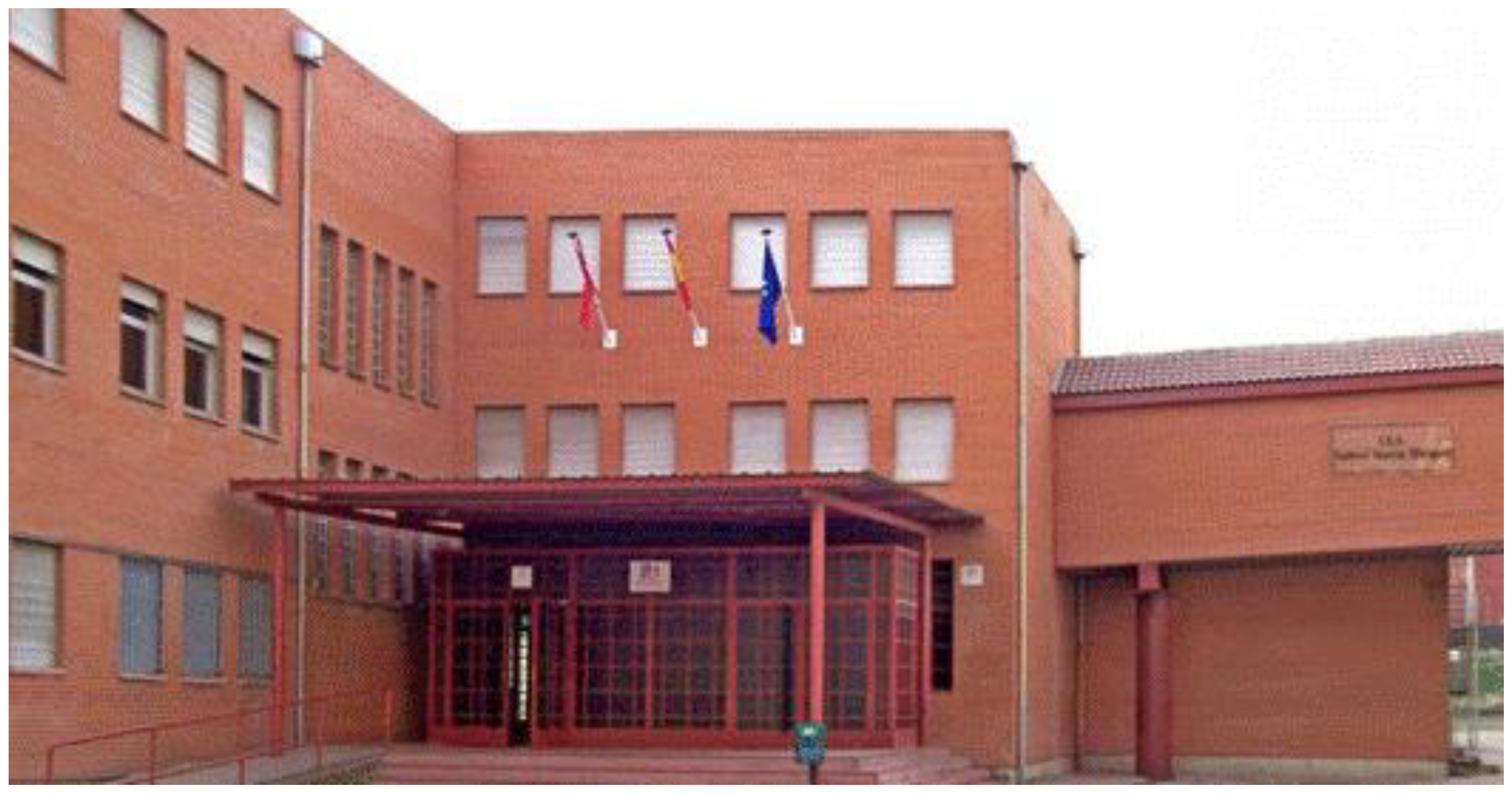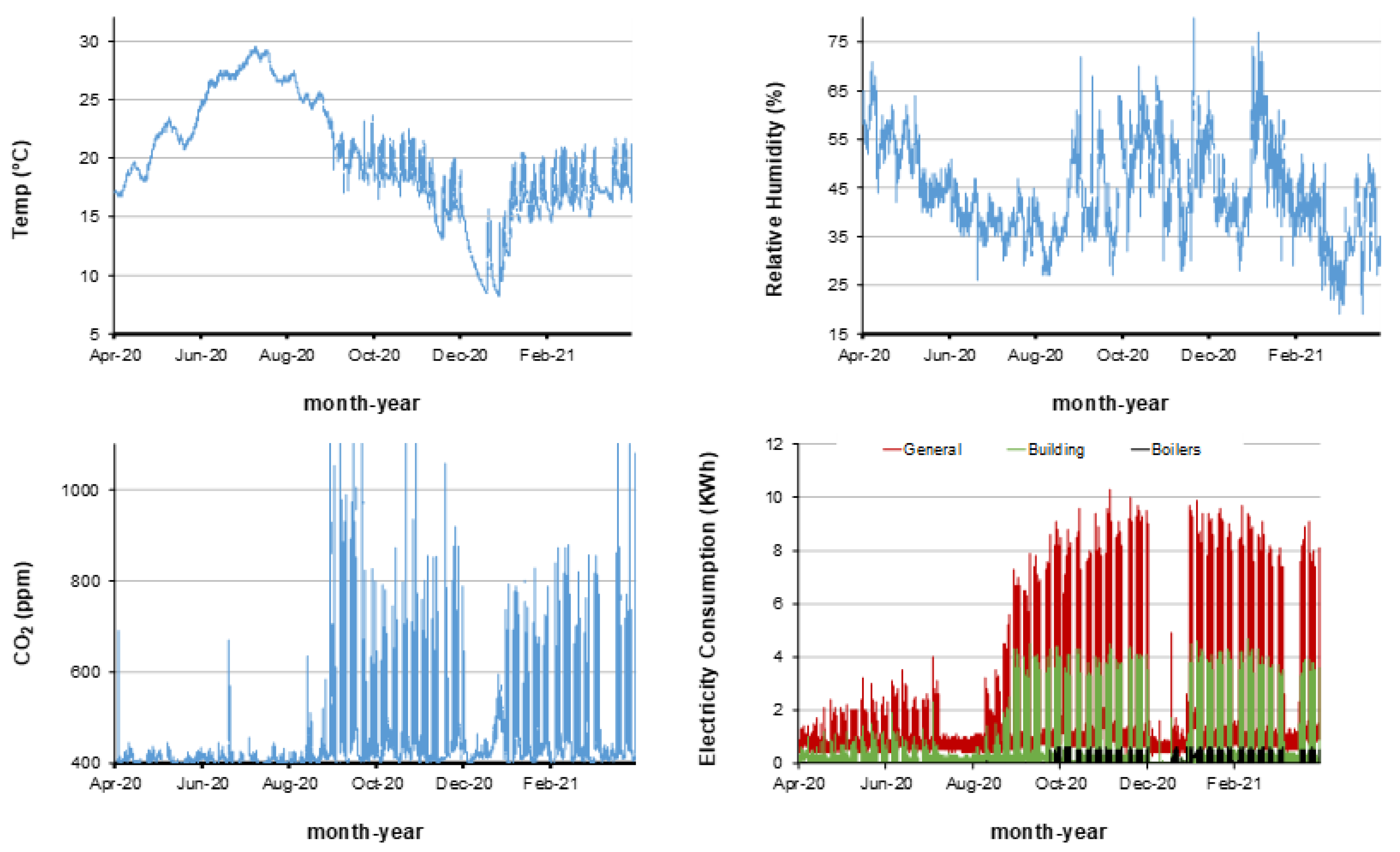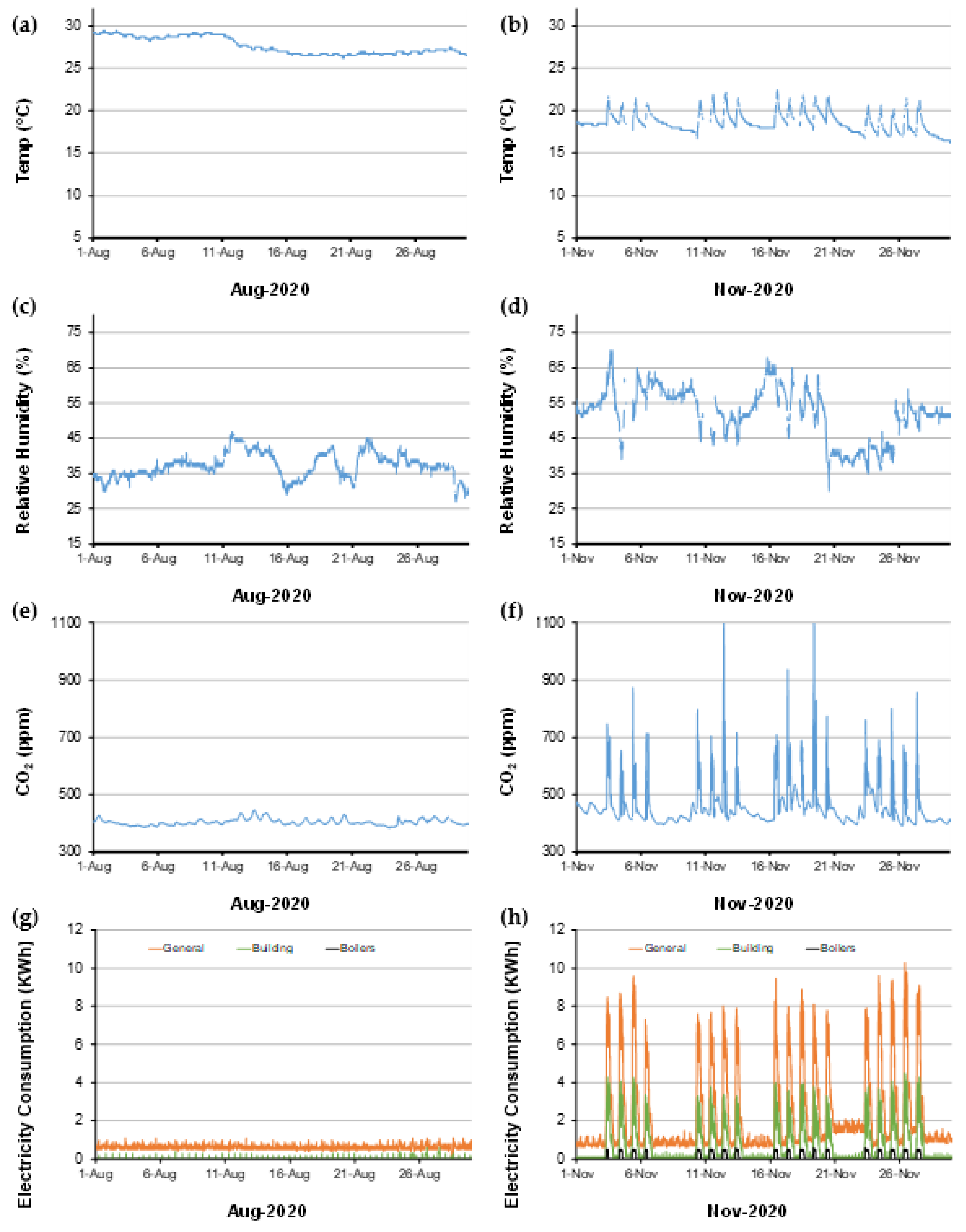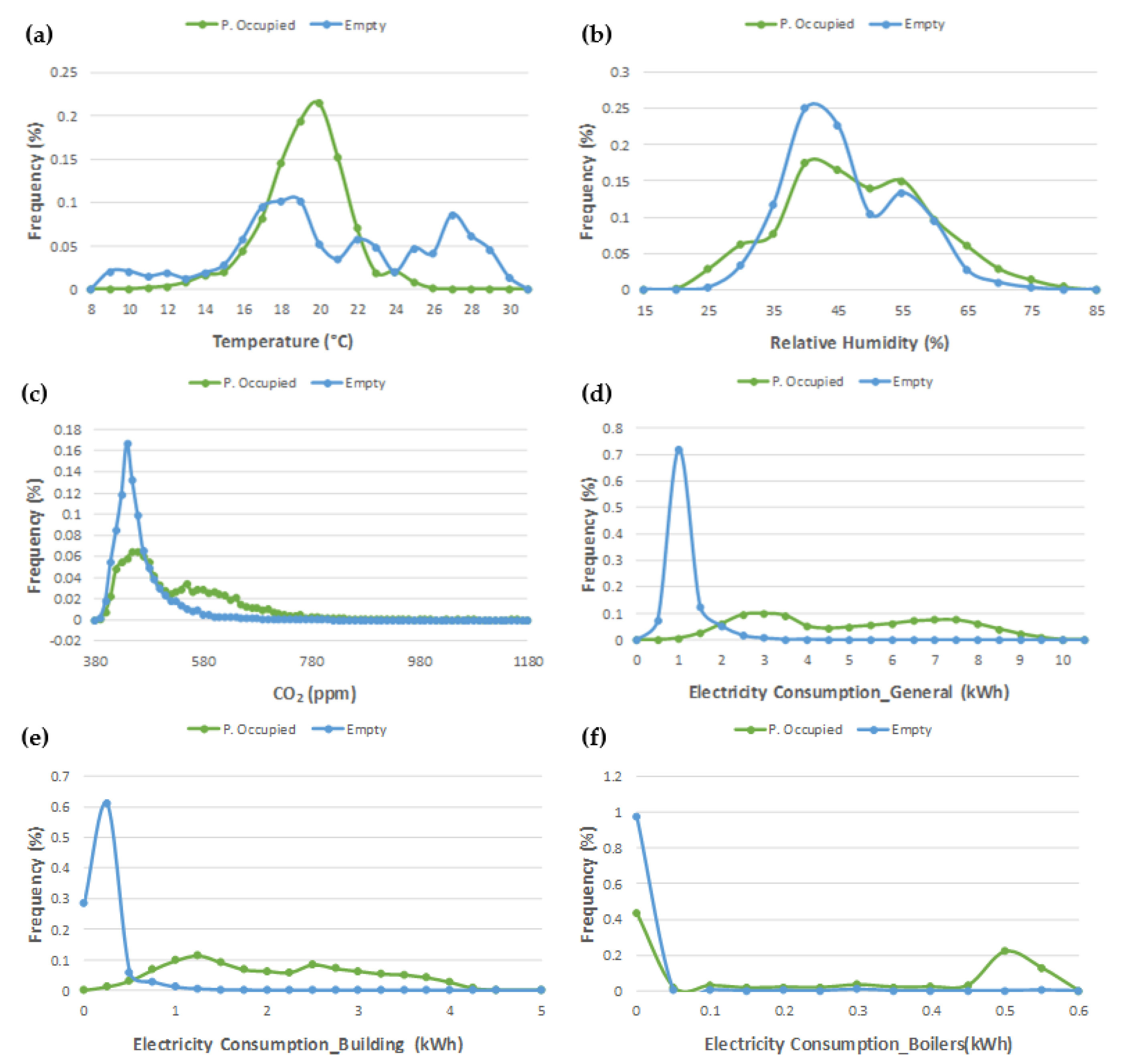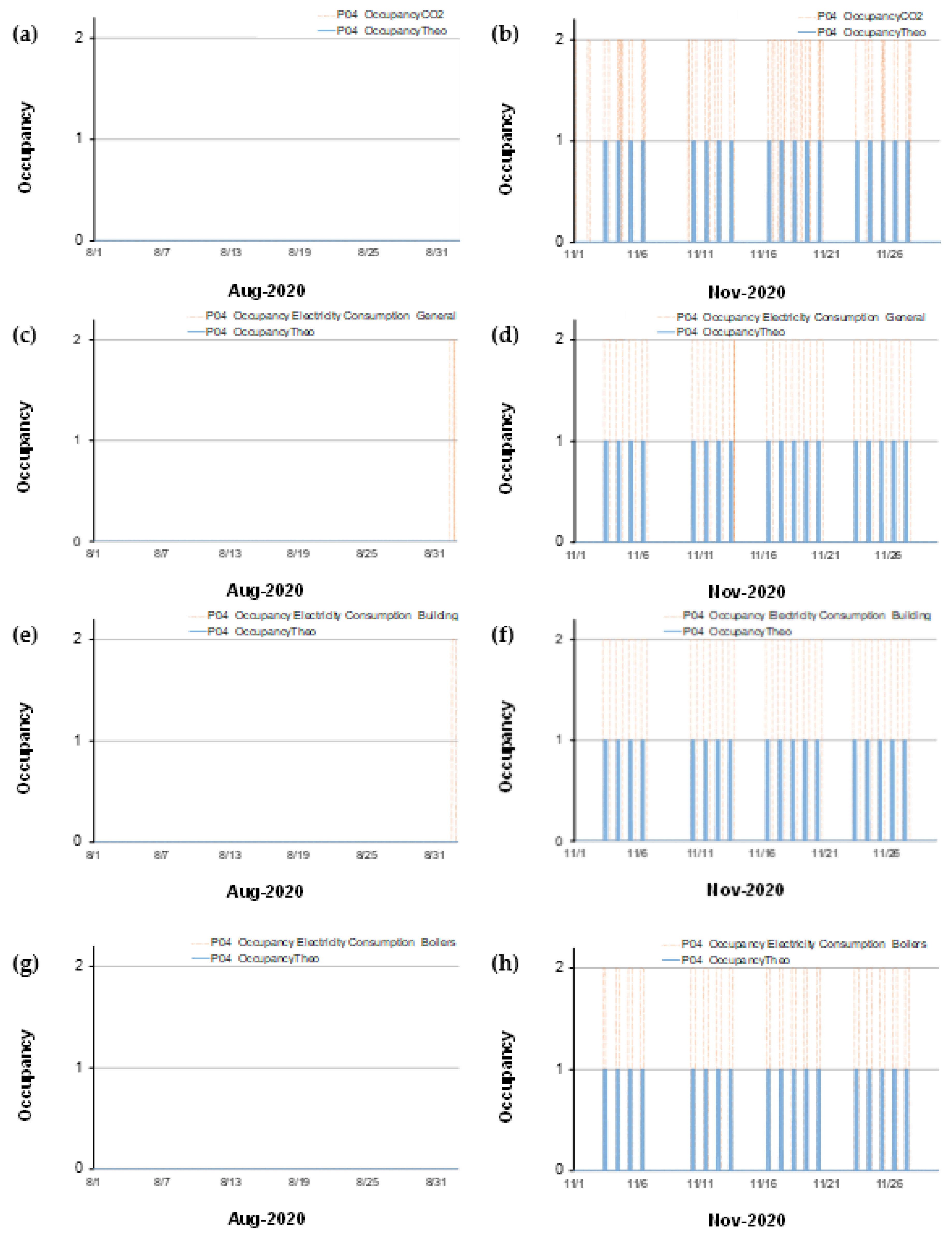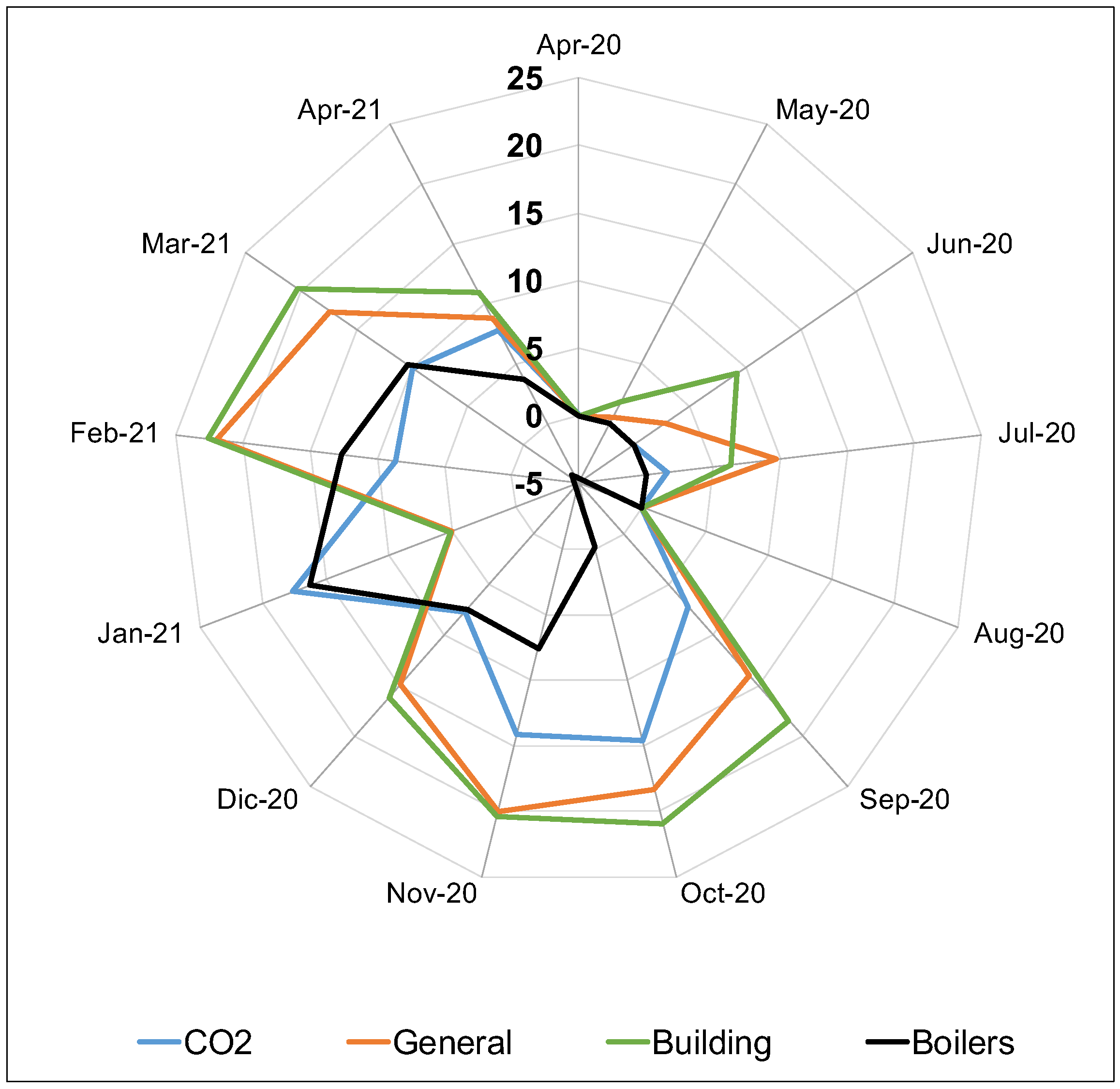1. Introduction
Current environmental threats, as well as the scarcity of resources and the impact of climate change, are a major concern for the sustainable development of cities [
1,
2], with districts playing an important role in the transition to climate-neutral cities [
3]. Under this framework, 17 Sustainable Development Goals (SDGs) have been defined in the 2030 Agenda [
4], whose objective is to promote sustainable development in cities. Quality education, climate change, clean energy or sustainable cities are key factors to achieve the energy transition. Aver et al. [
5] highlighted the importance of a quality education (SDG 4) in achieving the SDGs and proposed some recommendations that can be applied at different educational levels. Fulzele et al. [
6] conceptually analyzed the impact that the COVID-19 pandemic had on the environment and energy SDGs (7—Affordable and clean energy, 9—Industry, innovation and infrastructure and 13—Climate action), finding positive and negative factors in all cases. The quantification of this influence was done through a methodology based on the severity and importance of the impact on the SDGs. Their conclusions showed a lesser impact of the pandemic on SDG 7, a stagnant process on SDG 9, and a negative impact on SDG 13. Ameli et al. [
7] assessed different post-COVID-19 scenarios to minimize the negative effects on the achievement of the SDG objectives in Iran, using a qualitative method based on fuzzy cognitive maps. In this study, five strategies (eco-management, sustainable food, market revitalization, inclusive education and support in the energy sector), and combinations of them, and three post-COVID-19 scenarios were considered.
Energy efficiency measures [
8] can help to achieve the SDG objectives. Nurunnabi et al. [
9] assessed how these measures enhance corporate social responsibility (CSR) in a way that facilitates compliance with the SDGs, especially with SDG 7. Di Foggia [
10] showed that energy efficiency measures must meet the requirements of citizens and industry in order to achieve the SDGs. This study, based on the analysis of empirical data collected and published by the Financial Institutions Group, identified the following critical drivers: standardization, low transaction costs, energy prices, and stability of the regulatory framework.
With regard to the legal framework, different European governments adopt directives focused on the construction of more efficient buildings [
11], enabling inclusive and dynamic urban growth [
12]. This growing interest in promoting energy efficiency in buildings has highlighted the need to increase the knowledge of the energy performance of buildings and the use of effective solutions [
13] and validated design approaches [
14]. In this context, occupant behavior is one of the key sources of uncertainty for building energy analysis, being also one of the main causes of the performance gap [
15]. Multiple international initiatives are focused on potentially contributing to energy saving targets from behavior measurements [
16] and further developing occupant simulation [
17,
18]. Hou et al. [
19] incorporate the interaction between building occupancy and urban systems considering users’ Wi-Fi connections. Other authors proposed electric load profiles from smart meter readings to model occupancy profiles in residential buildings [
20]. Mitra et al. [
21] evaluate occupancy schedules in residential buildings in the USA from cluster analysis of the overall U.S. population’s activities, throughout twelve years. Additionally, occupancy profiles of non-residential buildings were determined by clustering mobile positioning data from social media platforms [
22]. Moreover, aggregated building stocks are especially affected by this performance gap. Bianchi et al. [
23] developed an approach to modeling occupancy-driven building loads to better estimate the impact of energy conservation measures. Most of the previous analyses were focused on residential buildings and the current time particularities due to the fact that higher ventilation requirements have to be further evaluated [
24].
This paper is focused on the experimental assessment of the occupancy pattern, as input that can contribute to improving the reliability of the energy performance assessment of buildings. Indeed, occupation is precisely identified as one of the most relevant issues that have an influence. This research analyses the suitability of different variables to obtain the occupancy patterns from measurements recorded by on-board monitoring systems in an in-use educational building. The aim was to identify which one represents this variable more accurately, helping to reduce more effectively the discrepancies between measured and simulated energy consumption.
Indoor air temperature, relative humidity and CO2 concentration are variables affected by human presence. Furthermore, electricity consumption due to artificial lighting, computers or thermal conditioning systems are also related to occupancy levels. Therefore, all these four variables were evaluated as occupancy indicators for this type of buildings.
The proposed approach has been applied to a classroom of a public high school in Madrid. The classroom has different levels of occupancy and users with different habits depending on the subject taught. The schedule for the schoolchildren has been used as a reference to validate the results. The future studies will focus on a comparison with the occupancy patterns normally used in the simulation of educational centers. This will allow the quantification of the impact of this improvement and its application to the modeling of this type of building.
The paper was structured in the following way: first, technical basics are described, then we describe the experimental set up and the devices required in the monitoring of a reference classroom. Thirdly, a description of the experimental campaign is carried out. Finally, the methodology applied to obtain occupancy patterns in educational buildings was defined.
3. Methodology: Occupancy Pattern Assessment
The methodology was focused on the experimental assessment of the occupancy profiles in schools to enhance building performance evaluation. School occupancy patterns were closely linked to the duration and frequency of the classes and the corresponding standstill periods. These particularities had a significant impact on energy use and building management.
The objective of this methodology was to assess the suitability of different variables to obtain the occupancy profiles in schools. In this research, the methodology was applied to a reference classroom. The indoor air temperature, the relative humidity, the CO2 concentration, and the electricity consumption measurements were proposed as candidate variables to be used as occupancy indicators. These variables were obtained from measurements recorded by building monitoring/control systems. The recorded variables do not allow the actual occupancy level of the classroom (the number of people in the classroom) to be obtained, but to estimate its occupied/empty status. However, this information is sufficient to achieve the objective of the proposed methodology, that is, to further investigate different variables as possible indicators of occupancy patterns but considering non-intrusive and cost-effective measurements as critical factors.
3.1. Preliminary Analysis: Data Overview
First, recorded data overview and data pre-processing was done. The classroom occupancy profiles of the different candidate variables were assessed and compared. A sensitive handling of data was done before estimating the occupancy pattern of the classroom. Indoor air temperature, relative humidity, CO2 concentration, and total electricity consumption were measured and evaluated as indicators of the occupancy status.
The typical annual behavior of these variables is displayed in
Figure 3. In addition,
Figure 4 shows daily and weekly patterns of these four variables evaluated in a monthly period. Two months were compared, corresponding to vacation and school term periods (August 2020 and November 2020, respectively). These two periods represented opposite statuses with respect to the level of occupation. These qualitative analyses evidenced some correlation between the variables and the occupancy status of the classroom.
Depending on the candidate variable analyzed, the preliminary analysis (
Figure 3 and
Figure 4) showed more or less clearly two differentiated statuses of the classroom occupancy: empty and occupied. These figures provide a first assessment, qualitative in this case, of the correlation between each variable and the occupancy status of the classroom. Each variable considered as a candidate indicator (indoor air temperature, relative humidity, CO
2 concentration, and total electricity consumption) showed some degree of dependency with the occupancy status, being within a range when the office was occupied and in another range when it was empty. Therefore, these unknown ranges must be determined quantitatively from the data measurements.
Since any numerical value of these variables must be in a range that corresponds to the occupied or empty status, the sensitive handling of data determined the corresponding periods for each status. All candidate variables were affected by the classroom occupancy, but
Figure 4 showed this dependency was more evident for the CO
2 concentration, and total electricity consumption data. However, the precise identification of reliance between the variables and occupancy status must be further discussed. Therefore, and based on previous studies [
30,
31], one-hour moving averages of data are used to better identify the occupancy patterns. This technique avoids fluctuations in measurements that do not come from changes in the occupancy status of the classroom.
The performances of combinations of variables were assessed in a previous work where we applied the same methodology [
30,
31], and the studied combinations did not perform better than using just one variable. According to this finding, we have limited this work not considering combinations.
3.2. Measurement Ranges for Occupancy
Histograms of candidate variables were generated to refine the measurement ranges associated with classroom occupancy status. One-hour moving averages of data measurements were used to generate these histograms. Full data range was divided in consecutive subranges, and data occurrences associated to each one, identified the different classroom occupancy levels. Data subranges were defined based on different intervals depending on the candidate variable as shown in
Table 1.
Regarding the electricity consumption, since accuracy depends on the load of the system, the accuracy of class 0.5 in electric consumption in
Table 1 means that the accuracy is 0.5% of the reading under full load and unity power factor.
Preliminary data analyses, based on qualitative observations, conclude that the school is always empty on Monday to Friday from 20:00 h to 7:00 h, and for the whole day at the weekends and holidays. This criterion was fixed to determine the ranges of empty occupancy status linked to each candidate variable. On the other hand, it is not possible to ensure when the classroom was certainly occupied. However, the classroom was probably occupied when the data values were other than the previously established ranges.
According to this limitation, occupancy patterns of the classroom were determined for the two following statuses: certainly empty and probably occupied. Then, the global number of occurrences at each status normalized the generated histograms. The intersection of both histograms represented the breakpoint for a change in the classroom occupation status. A systematic method was applied to find the breakpoints from the histograms of the datasets. The calculation of the intersection points was based on a function developed in Matlab [
32]. This function determines whether or not intersection occurs in each pair of line segments generated from the input data of each variable histogram (empty/occupied). To speed up the process, the function performs a preliminary check to eliminate pairs of line segments that could not possibly intersect.
Once the corresponding occupancy breakpoints were determined for each candidate variable, the classroom occupancy patterns were estimated and compared. The expected classroom occupancy detailed in the next section in
Table 2 was used to validate these results.
These established ranges for the different indicators, except for the electricity consumption, could be modified by the user’s habits, being the status of door and windows (open or close) during school hours one of the most critical. The effect on occupancy patterns regarding this issue was not assessed in this research due to the lack of information. Another factor affecting the candidate variables was the operation of conditioning systems.
3.3. Theoretical Occupancy Patterns Identification
The student time schedule was used as the theoretical reference to validate the estimated occupancy patterns. The theoretical occupancy values of the selected classroom are specified in
Table 2.
These values refer to the theoretical total number of people in the classroom, including the students and the teacher. The real occupancy values can be obtained through different pathways.
The most direct way refers to information on student school attendance. Unfortunately, there were no accessible records of student absences during the evaluated academic year, so there is no real information on the number of people. Although, a one-day experimental campaign was conducted with the collaboration of the occupants, and real occupancy data were recorded for this period. Other options related to direct measurements using occupant detection methods such as chair/desk sensors, cameras, etc., were ruled out in this methodology to ensure non-intrusiveness and cost reduction.
In summary, and taking into account these limitations, the methodology is applied to determine from which measured variables the occupancy status of the enclosures can be determined, but not their occupancy level.
3.4. Accuracy of the Estimated Occupancy Patterns
The accuracy of the estimated occupancy patterns was analyzed for each candidate variable. The obtained indicators were used to quantify the different occupancy approaches. Deviation from the theoretical occupancy times taken as reference (
Table 2) was calculated. The difference between the estimated hours of occupation and the academic school hours was expressed as a percentage.
The most proper approach for classroom occupancy pattern estimation combined both maximum performance and minimum intrusiveness and cost, and referred to the monitoring system.
4. Results
Occupancy profiles in schools to enhance building performance assessments were experimentally obtained and the main results are presented in this section.
4.1. Candidate Occupancy Pattern Variables: Histograms Overview
The histograms of the different candidate variables are displayed in
Figure 5. This figure shows different occupancy profiles. Depending on the overlapping degree of the curves representing the two occupancy statuses, the accuracy achieved in determining occupancy threshold is different.
The temperature and relative humidity curves in
Figure 5a,b present a wider and flatter shape. In consequence, it is difficult to establish a clear occupancy status breakpoint due to the significant overlap degree between the occupancy status curves. Therefore, air temperature and humidity were discarded as ineffective occupancy indicators because they do not provide accurate estimations.
The histograms of CO
2 concentration in
Figure 5c, as well as histograms associated with electricity consumption measurements (
Figure 5d–f), show narrow and pointed shapes. In this case, due to the lower overlapping degree, the occupancy status breakpoint was certainly identified. This performance was mainly observed in the cases of global and building electricity consumption. So, these last four candidate variables are suitable to obtain the classroom occupancy patterns.
Table 3 shows quantitative results, identifying the cut-off points for occupancy status, i.e., the value of the variables from which the room is occupied.
The dashes in the table show that, as previously indicated, it was impossible to determine a clear breakpoint for either temperature or humidity values. For the rest of the variables, the value of the threshold used to obtain the experimental occupancy patterns is indicated.
4.2. Classroom Occupancy Patterns
Estimated and theoretical occupancy patterns are displayed in
Figure 6 from suitable variables: the CO
2 concentration (
Figure 6a,b) and the measurements associated to electricity consumption (
Figure 6c–h). Monthly periods are displayed to evidence daily and weekly occupancy patterns from each suitable variable. School and vacation periods present an opposite behavior with respect to the level of classroom occupation. Two months were assessed and compared, respectively belonging to different period typology (school or vacation).
Figure 6 shows the positive occupancy status in the classroom by comparing the theoretical occupancy status with the estimated one (obtained from the experimental measurements). The value 1 in occupancy, in the case of the theoretical pattern (blue bar), refers to the fact that during these hours the classroom is theoretically occupied, not to the number of people occupying it. Similarly, the value 2 in occupancy, in the case of the experimental patterns (orange bar), refers to the fact that during these hours the experimental measurements indicate that the classroom was occupied, not to the number of people occupying it. Thus, to facilitate the visualization of the graphs, the unit value of theoretical occupancy patterns (blue bars) indicating that the classroom was theoretically occupied, was increased to the value two for the estimated status identified experimentally as occupied. Both estimated and theoretical patterns had zero value at empty classroom status.
The four suitable variables developed similar occupancy patterns throughout the year.
Figure 6 showed that the reference classroom was empty at night and early in the morning during school days, the weekends, and holidays (i.e., 2 November 2020 or August 2020). However, there are some discrepancies in occupancy patterns depending on the variable used as an indicator.
Occupancy patterns from electricity consumption indicators presented more uniform patterns of occupancy on school days. The number of hours of classroom occupancy is the same every school day. This value overestimates the theoretical number of teaching hours in the reference classroom with the exception of profiles derived from the boilers electrical consumption. The boilers electric consumption is a very successful pattern indicator in the non-occupancy periods i.e., holidays, when this conditioning system was not in operation. For the rest of the year the pattern identified from this indicator was equally successful. However, this indicator differed greatly from the theoretical pattern in the coldest month, as well as from the patterns generated from the other electrical indicator variables.
The occupancy patterns obtained from the CO2 concentration indicator presented irregular occupancy profiles throughout the week during school days. It better fits the theoretical occupancy derived from the scholar schedule. However, at certain times during school hours, the room is theoretically identified as empty, but it is identified as occupied according to the CO2 concentration. Observed discrepancies could be explained either by the early entry of students into the classroom, the permanence of a student inside the classroom in the recessed time between classes, or the CO2 concentration decay once the classroom is empty.
4.3. Occupancy Patterns Performance
In this section, a quantitative assessment of the correlations found between occupancy and the investigated variables is showed as a deviation percentage of estimated occupancy patterns from the theoretical ones taken as reference.
To this end, the difference between the times the classroom was occupied according to each variable indicator minus the times the classroom was planned to be occupied according to the official scholar schedule of this classroom was calculated. This difference is displayed as a percentage of hours for each month in
Figure 7. The figure shows deviations lower than 25% in all indicator variables, with a global mean deviation of 8.4%. Boilers electricity consumption and CO
2 indicators presented the lowest mean percentages of 5% and 7%, respectively. On the contrary, general and building electricity consumption indicators reached higher mean percentages, up to 10% and 11%, respectively.
The occupancy patterns derived from general and building electricity consumption presented some similar behavior throughout the year.
Occupancy patterns from boilers indicators showed low deviations, comparable to the deviations observed for the CO2 indicator in the first and last five months of the considered period. The deviations for the other considered months were slightly larger for the CO2 indicator.
5. Discussion
The occupancy patterns and rates in enclosed areas vary according to the type of activity carried out. The interest of this study is precisely to analyze the impact of the type of activity carried out at the site on the replicability of the developed methodology. In previous studies [
30,
31], in which this same methodology was applied, the rooms evaluated were office rooms characterized by different occupancy patterns and rates. In this case, the evaluated room is a classroom. The type of activity also affected the datasets to be analyzed as possible indicators. In previous studies, the variables analyzed were related to measurements inside the room. In this case, more general measurements were tested, at building level (electric variables) and not just at room level (air temperature, relative humidity and CO
2 concentration).
Optimal variable indicators for the estimation of occupancy patterns are affected by the occupancy rate, that is, the number of people in the room. In previous studies, we have observed that the level of occupancy affects the viability of CO
2 concentration as an optimal indicator. In the previous study [
30], in which it was concluded that CO
2 concentration was “not as informative as expected”, the occupancy level was low, below three people/room. We had observed the same pattern in the Díaz-Hernández et al. [
31] study. In the case of offices with low occupancy rates (one or two people/room), the concentration of CO
2 as an indicator of occupancy was not as informative as expected. However, the room case with a higher occupancy level (up to ten people) identified CO
2 concentration as an optimal indicator. In our study, the number of people increases to a value of twenty-two in some subjects, the most common value being fifteen.
The complexity in measuring the CO
2 concentration in occupied spaces should also be noted. Previous studies highlight the relevance of ventilation strategies and air movement on its spatial uniform distribution in a room. In fact, the building ventilation strategy influences the impact of occupancy rates and air changes in indoor CO
2 distribution. In this regard, Styme et al. [
33] report a vertical CO
2 concentration stratification in a room ventilated by a displacement system. Bulinska et al. [
34] evaluated the CO
2 distribution in naturally ventilated spaces concluding that sensors should be positioned either in the center of the room or towards the airflow outlet door. Pei et al. [
35] conclude that mixing ventilation generates horizontal and vertical CO
2 uniform distributions and therefore, in this case, the sensor location in the room is not relevant. Finally, Mahyuddin and Awbi [
36] provide general procedures on the optimal positioning of CO
2 sensors in a room. In this study, the sensors were positioned according to these guidelines.
Power consumption of equipment (PCs) is a good indicator for offices occupancy, but not for classrooms where electrical devices are not always used. In this latter case, more general electricity consumption measurements referring to the building and not to the classroom were found to be more appropriate as occupancy indicators.
The results of this study are limited to the estimation of the occupancy status in order to simplify the monitoring requirements. So, the indicators were suitable in the determination of whether or not an enclosure is occupied, but not in determining the number of people inside it.
6. Conclusions
Air temperature and relative humidity were both discarded as viable indicators of classroom occupancy patterns. On the contrary, the CO2 concentration as well as the electricity consumption variables proved to be optimal indicators for the estimation of these occupancy patterns.
However, these selected indicators presented some deviations between the estimated and the theoretical occupancy status. It depends on the variable used to generate the classroom occupancy pattern, but they were predominantly positive. That means the estimated classroom occupancy hours were higher than the theoretical ones. The higher the occupancy, the greater the uncertainty introduced by the users’ behavior. Therefore, the impact of users is a phenomenon to be analyzed in depth in future studies. Different factors depending on the type of indicator variable could explain the pattern’s uncertainties.
Even though the occupancy patterns identified from the boilers electrical consumption indicator had a good accuracy in the evaluated periods, they presented significant deviations in the coldest month. An increase in boiler operating hours to ensure indoor comfort conditions during school hours could explain this overestimation in occupancy. The same pattern was observed for the CO2 indicator, although, in this case, this overestimation was also observed during the autumn months.
The occupancy pattern derived from the boilers electric consumption presented a particularity: classroom occupancy was not detected if, due to mild weather conditions, the heating systems were not operating. This fact was observed in September, at the beginning of the academic year. The occupancy patterns generated from the rest of valuable variables did not present this problem.
